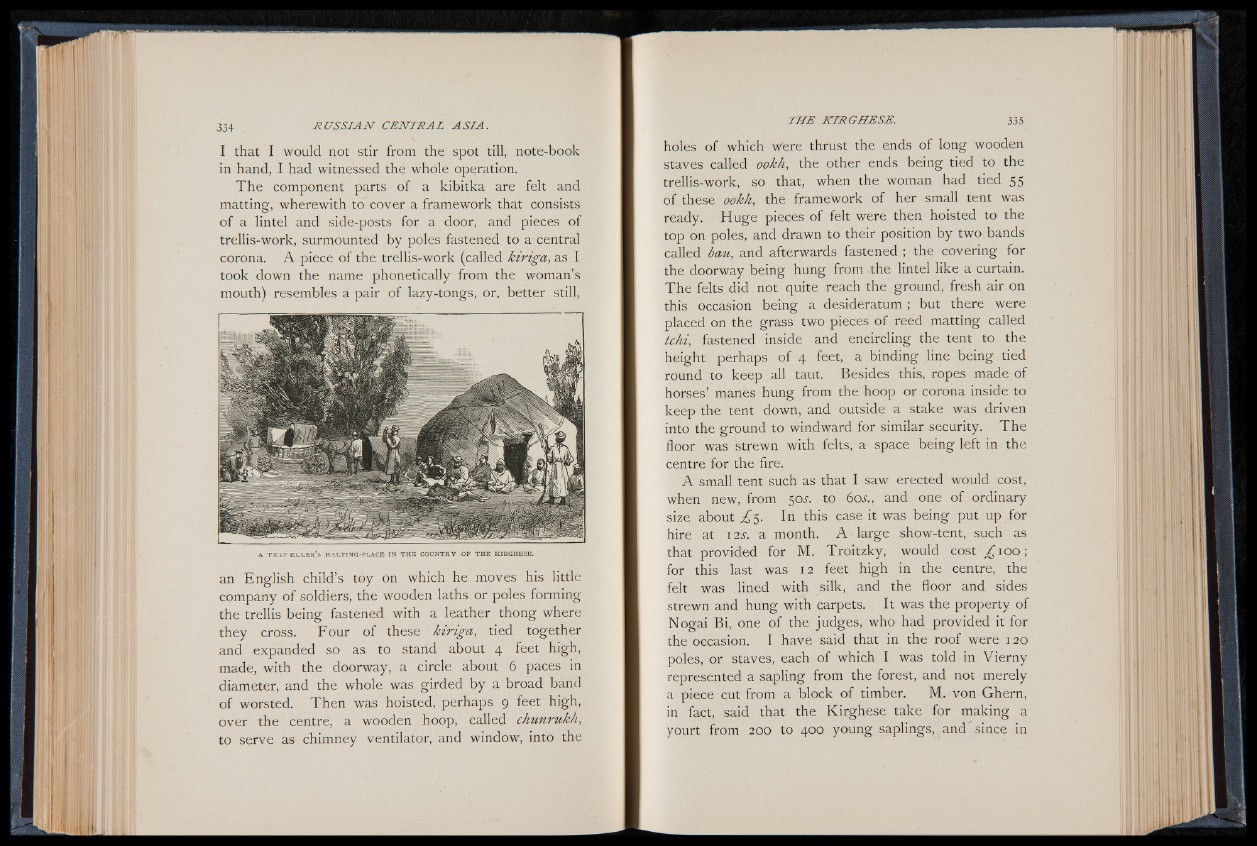
R U S S IA N C EN TR A L A S IA . THE K IR GH E SE .
an English child’s toy on which he moves his little
company of soldiers, the wooden laths or poles forming
the trellis being fastened with a leather thong where
they cross. Four of these kiriga, tied together
and expanded so as to stand about 4 feet high,
made, with the doorway, a circle about 6 paces in
diameter, and the whole was girded by a broad band
of worsted. Then was hoisted, perhaps 9 feet high,
over the centre, a wooden hoop, called chunrukh,
to serve as chimney ventilator, and window, into the
holes of which Were thrust the ends of long wooden
staves called ookh, the other ends being tied to the
trellis-work, so that, when the woman had tied 55
of these ookh, the framework of her small tent was
ready. Huge pieces of felt were then hoisted to the
top on poles, and drawn to their position by two bands
called bau, and afterwards fastened ; the covering for
the doorway being hung from the lintel like a curtain.
The felts did not quite reach the ground, fresh air on
this occasion being a desideratum ; but there were
placed on the grass two pieces of reed matting called
tchi, fastened inside and encircling the tent to the
height perhaps of 4 feet, a binding line being tied
round to keep all taut. Besides this, ropes made of
horses’ manes hung from the hoop or corona inside to
keep the tent down, and outside a stake was driven
into the grpund to windward for similar security. The
floor was strewn with felts, a space being left in the
centre for the fire.
A small tent such as that I saw erected would cost,
when new, from 50s. to 6ctf., and one of ordinary
size about ¿ 5 . In this case it was being put up for
hire at 12s. a month. A large show-tent, such as
that provided for M. Troitzky, would cost ¿ i o o ;
for this last was 12 feet high in the centre, the
felt was lined with silk, and the floor and sides
strewn and hung with carpets. It was the property of
Nogai Bi, one of the judges, who had provided it for
the occasion. I have said that in the roof were 120
poles, or staves, each of which I was told in Vierny
represented a sapling from the forest, and not merely
a piece cut from a block of timber. M. von Ghern,
in fact, said that the Kirghese take for making a
yourt from 200 to 400 young saplings,, and since in
I that I would not stir from the spot till, note-book
in hand, I had witnessed the whole operation.
The component parts of a kibitka are felt and
matting, wherewith to cover a framework that consists
of a lintel and side-posts for a door, and pieces of
trellis-work, surmounted by poles fastened to a-central
corona. A piece of the trellis-work (called kiriga, as I
took down the name phonetically from the woman’s
mouth) resembles a pair of lazy-tongs, or, better still,
A t r a v e l l e r 's HALTING-PLAÇE IN THE COUNTRY OF THE KIRGHESE.